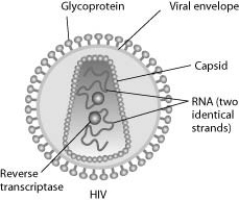Use the paragraph and accompanying figure to answer the following questions.
Human immunodeficiency virus (HIV) infects cells that have both CD4 and CCR5 cell surface molecules. The viral nucleic acid molecules are enclosed in a protein capsid, and the protein capsid is itself contained inside an envelope consisting of a lipid bilayer membrane and viral glycoproteins. One hypothesis for viral entry into cells is that binding of HIV membrane glycoproteins to CD4 and CCR5 initiates fusion of the HIV membrane with the plasma membrane, releasing the viral capsid into the cytoplasm. An alternative hypothesis is that HIV gains entry into the cell via receptor-mediated endocytosis, and membrane fusion occurs in the endocytotic vesicle. To test these alternative hypotheses for HIV entry, researchers labeled the lipids on the HIV membrane with a red fluorescent dye.

-What would be observed by live-cell fluorescence microscopy immediately after HIV entry if HIV is endocytosed first, and then later fuses with the endocytotic vesicle membrane?
A) A spot of red fluorescence will be visible on the infected cell's plasma membrane, marking the site of membrane fusion and HIV entry.
B) The red fluorescent dye-labeled lipids will appear in the infected cell's interior.
C) A spot of red fluorescence will diffuse in the infected cell's cytoplasm.
D) A spot of red fluorescence will remain outside the cell after delivering the viral capsid.
Correct Answer:
Verified
Q48: The voltage across a membrane is called
Q56: Diffusion of ions across membranes through specific
Q59: A sodium-potassium pump _.
A) moves three potassium
Q63: Three lab groups carried out an experiment
Q64: Three lab groups carried out an experiment
Q64: Which of the following factors would tend
Q65: In what way do the membranes of
Unlock this Answer For Free Now!
View this answer and more for free by performing one of the following actions

Scan the QR code to install the App and get 2 free unlocks

Unlock quizzes for free by uploading documents